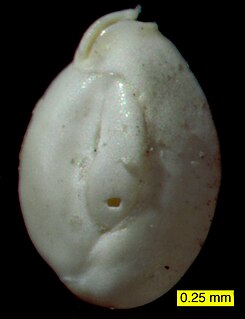
Foraminifera are single-celled organisms, members of a phylum or class of amoeboid protists characterized by streaming granular ectoplasm for catching food and other uses; and commonly an external shell of diverse forms and materials. Tests of chitin are believed to be the most primitive type. Most foraminifera are marine, the majority of which live on or within the seafloor sediment, while a smaller number float in the water column at various depths. Fewer are known from freshwater or brackish conditions, and some very few (nonaquatic) soil species have been identified through molecular analysis of small subunit ribosomal DNA.

The Globigerinina is a suborder of foraminiferans that are found as marine plankton. They produce hyaline calcareous tests, and are known as fossils from the Jurassic period onwards. The group has included more than 100 genera and over 400 species, of which about 30 species are extant. One of the most important genera is Globigerina; vast areas of the ocean floor are covered with Globigerina ooze, dominated by the shells of planktonic forms.

The Fusulinida is an extinct order within the Foraminifera in which the tests are composed of secreted hyaline calcite. Like all forams, they were single-celled organisms. In advanced forms the test wall was differentiated into two or more layers. Loeblich and Tappan, 1988, gives a range from the Lower Silurian to the Upper Permian, with the fusulinid foraminifera going extinct with the Permian–Triassic extinction event. While the latter is true, a more supported projected timespan is from the Mid-Carboniferous period.

Quinqueloculininae is a subfamily in the family Miliolidae of miliolid foraminifera.
Discorbacea, Discorboidea in recent taxonomies, is a superfamily of foraminifera,, with a range extending from the Middle Triassic to the present, characterized by chambers arranged in a low trochspiral; an umbilical or interiomarginal aperture, with or without supplementary apertures; and a wall structure that is optically radial.
Abathomphalus is a genus of foraminifera included in the Globotruncanid family.
Ninella is a genus of fusulinicean forams from the Lower Carboniferous included in the family Ozawainellidae and subfamily Pseudostaffellinae.

Cibicides is a genus of cosmopolitan benthic foraminifera known from at least as far back as the Paleocene that extends down to the present.
Discorbis is a genus of benthic Foraminfera, that made its first appearance during the Eocene. Its present distribution is cosmopolitan.
Astrononion is a genus of foraminifera in the family Nonionidae, characterized by an evolute planispiral test with radially stellate structures partly covering the sutures on either side. The test is free, bilaterally symmetrical; periphery broadly rounded; chambers distinct, separated by depressed radial sutures, increasing gradually in size, and usually inflated; aperture a low arched opening at the base of the face of the test. The wall is of finely perforate monolamellar granular calcite.
Hedbergella is an extinct genus of planktonic foraminifera from the Cretaceous, described by Loeblich and Tappan, 1961, as:
Test free, trochospiral, biconvex, umbilicate, periphery rounded with no indication of keel or poreless margin; chambers globular to ovate; sutures depressed, radial, straight or curved; wall calcareous, finely perforate, radial in structure, surface smooth to hispid or rugose; aperture an interiomarginal, extraumbilical-umbilical arch commonly bordered above by a narrow lip or spatulate flap, ... Includes species otherwise similar to Praeglobotruncana but which lack a keel or poreless margin, hence is regarded as a separate genus rather than as a subgenus of Praeglobotruncana as by Banner and Blow (1959).
The Pseudogaudryinidae is a family of Late Cretaceous to recent benthic aggultinated Foraminifera included in the Textulariida. Tests are elongate with an early triserial stage, later reduced to biserial or uniserial. Walls are of agglutinated material and are canaliculate, that is have micro-tubular cavities. Apertures, an interiomarginal arch. The Pseudogaudryinidae differs from the Verneuilinidae in the canaliculate wall and from the Valvulinidae in having a simple aperture with-out a tooth.
The Valvulinidae is a family of Paleocene to recent benthic textulariid Foraminifera characterized by trochospiral tests in the early stage which may become uniserial in the later. Walls are of cemented agglutinated material and have cavities created by micro-tubules, i.e. are canaliculate. Apertures have a valvular tooth or flap, at least in early stage, but may become multiple and areal in the later stage.
The Globoroatioidea constitutes a superfamily of Cenozoic plantonic foraminifera. It is part of the suborder Globigerinina. Globoroatioidea have trochospiral tests with rounded to carinate peripheries, the walls of which are of finely lamellar, perforate, of optically radial calcite, with an inner organic lining. The surface of these tests is smooth, lacking spines, but may be covered with pustules or pitted, and may have one or more large pores at the center. There is a single primary aperture that may be bordered by an imperforate lip, as well as possible supplementary apertures.
The Involutinidae are a family of foraminifera included in the Involutinida, characterized by calcareous tests consisting of an undivided planispirally to trochospirally coiled tubular second chamber wound around the initial proloculus, and which may have thickenings or nodes on one or both sides. This family includes four subfamilies, Aulotortinae, Involutininae, Triadodiscinae, and Triasininae.
Spirocyclinidae is a family of foraminifera included in the order Loftusiida.
Cyclamminidae is a family of Foraminifera in the order Loftusiida, ex textulariid subfamily Cyclammininae in the Treatise on Invertebrate Paleontology Part C, Protista 2.
Gavelinellidae is a family of foraminifera belonging to the superfamily Chilostomelloidea and the order Rotaliida. It is found in marine sediments of the Barremian and exists into the present-day (Holocene).
Praeglobotruncana is an extinct genus of foraminifera belonging to the family Hedbergellidae of the superfamily Rotaliporoidea and the suborder Globigerinina. Its type species is Praeglobotruncana delrioensis. Its fossil range is the Cretaceous Period.
Heterohelicidae is a family of foraminifera belonging to the superfamily Heterohelicoidea and the suborder Globigerinina.




